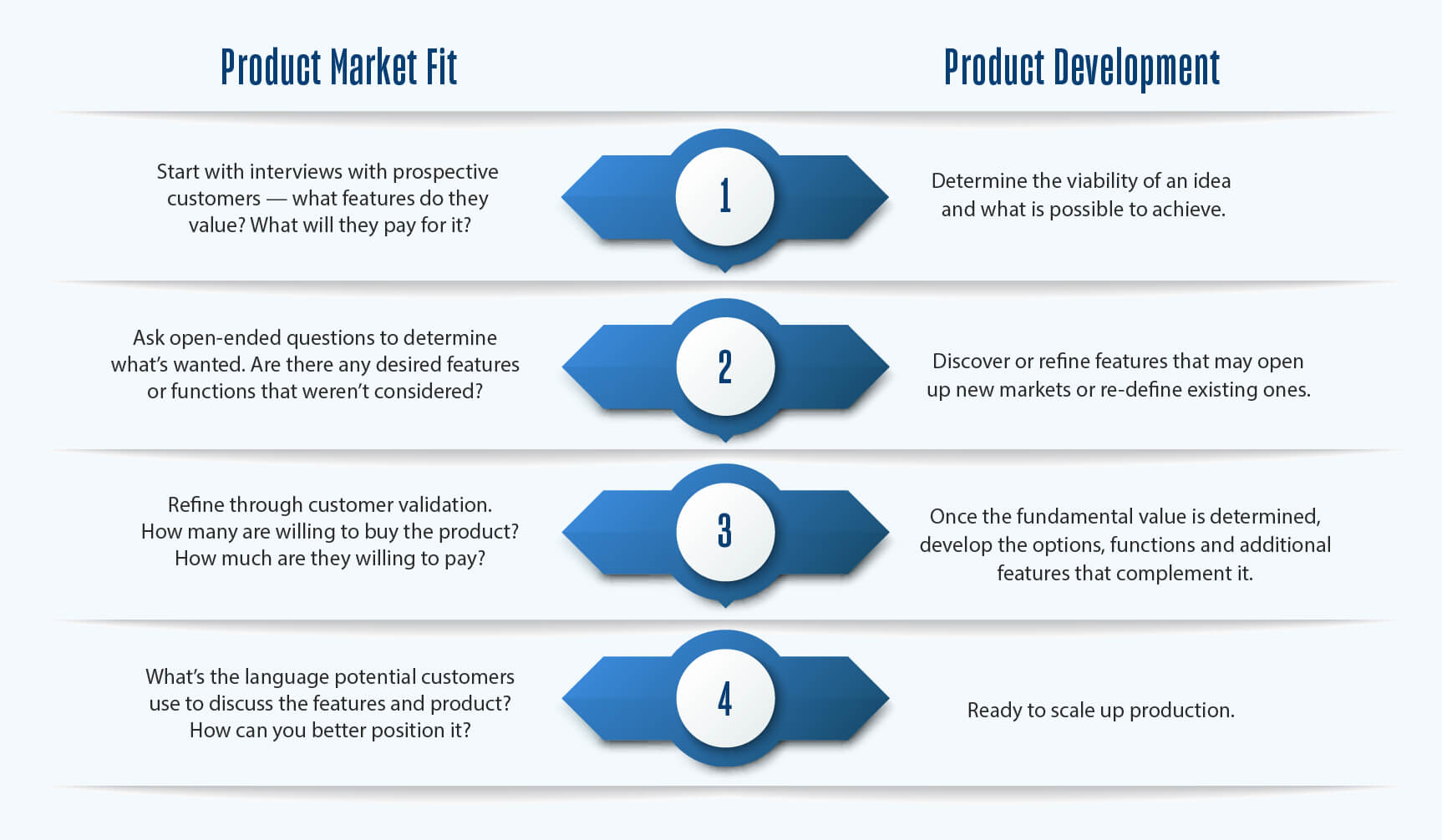If you have a novel concept or innovative idea that you’re thinking of bringing to market, it’s important to understand that success requires making the right moves, an investment of time and money and a little bit of luck.
The biggest mistake you can make in bringing a product to market is to develop a product for yourself and assume it’s going to sell. Coming up with a new convenience or solution for your own life is a good place to start, but it’s not where you need to finish.
Here are the most important considerations for developing a new product and what you need to accomplish before successfully selling to your customers.
Get Your Guide: The 4 Ways to Break Into a Tech Career (Plus 8 Lucrative Tech Careers to Pursue)
What Does Bringing a Product to Market Entail?
The most important thing you can do is to determine the value proposition of your product – how will potential buyers understand how your product will improve their lives?
It’s important to make a distinction between a product and an invention. A breakthrough solar cell is a great invention, but it’s the inexpensive solar panel that provides energy savings that is going to sell to a customer. An algorithm that more easily matches profiles is a great innovation, but it’s the promise of an easy-to-use dating service that’s going to get people to download your new app.
Your potential customers have to understand how this product will benefit them. What changes will it bring, how will it improve their lives or solve a problem? Determining those answers — discovering what’s called the product market fit — constitutes the major steps of bringing a product to market.
6 Steps to Bring a Product to Market
1) Refine your idea
Refining your initial idea through questions. Collaborate with a partner or mentor to talk through some fundamental ideas like:
- How will the product work?
- Who are the primary customers?
- Why will they want to use it?
- How practical is this product? How affordable?
- Is it easy to make or manufacture? Where can it be made?
- Has someone already come up with this product?
You might be surprised to learn that someone already beat you to the punch with an idea. That’s why it’s important to perform some preliminary research and even a patent search to see if your idea already exists.
If it does — don’t despair, because there’s other followup questions you can ask:
- How can that idea be improved upon?
- How can that product be made cheaper?
- How can the product be more efficient?
2) Identify your target market
When you feel that you have a solid idea nailed down, it’s time to narrow the focus of who the customers will be. Having a more precise target market means your market research will be more effective, which will save you time and money in the long term.
You’ll want to determine the ideal customers for this product. Here are some questions to ask:
- What are their demographics?
- What are their income levels?
- What are their buying habits?
- How are they currently solving the problem?
- How and where are they likely to purchase your product?
- Can the value proposition be quantified to justify the product or service price?
It’s okay to start with general assumptions, because the next step is where the real work begins.
3) Research your market
This is where you’ll determine your product market fit through a process of customer validation, also called market validation. Essentially, you have a great idea of a product — but will people actually buy it?
In the product development process, it can take surprisingly longer to get the market fit correct than to develop an MVP. Rather than wasting time on creating a product that won’t meet the needs of your customers, you can save some effort by nailing down the “must have” features that you’re trying to sell. Sometimes you’ll need a strong proposal backed by a proven value proposition to secure the capital or investments needed to build a working prototype.
It’s important to note that, depending on technology development for your product, some features may not be possible to achieve. Maybe the features aren’t currently cost-effective, maybe the existing infrastructure can’t support it, or maybe it’s just not yet achievable.
Depending on how the MVP production goes, you may need to re-think your proposal and pivot on the market fit. For example, the state-of-the-art chip you’re developing can’t achieve the audio fidelity you’re after, but it is providing incredible video quality for low cost. Is there a market for that?
Start with identifying any similar products in order to make comparisons in price and functionality. If you’re introducing something new, it can be helpful to make comparisons (“It’s like Zoom, but…” “Think of a smart car but….”). You’ll need to conduct as many interviews with representative customers as possible, whether through one-on-one discussions, by handing out surveys to volunteers, or creating online questionnaires.
The answers you get constitute your market discovery period and will let you know if you’re on the right track. Here’s where you need to be prepared to pivot your idea based on the feedback you’re receiving:
- If the response is aligning with your original assumptions, you’re on the right track.
- If the main selling point isn’t clicking with your audience, but other elements are, make those the important attributes of your product.
- If nothing is eliciting a positive response, it may be worth re-thinking the idea. Maybe you got the audience wrong, or maybe the timing isn’t quite right.
It is vitally important to get the value proposition right. You do not want to move toward investing time and money in scaling a business until you’re able to determine that you have a market for your product and customers who are willing to pay.
4) Create a prototype
When you’re confident that you have a good product market fit, you can move forward with developing a proof of concept for your product, the minimum viable product (MVP). An MVP does not need to be identical to the proposed final product; it just needs to get the key value across and showcase what’s unique about your offering.
In the product development process, it can take surprisingly longer to get the market fit correct than to develop an MVP. Rather than wasting time on creating a product that won’t meet the needs of your customers, you can save some effort by nailing down the “must have” features that you’re trying to sell. Sometimes you’ll need a strong proposal backed by a proven value proposition to secure the capital or investments needed to build a working prototype.
It’s important to note that, depending on technology development for your product, some features may not be possible to achieve. Maybe the features aren’t currently cost-effective, maybe the existing infrastructure can’t support it, or maybe it’s just not yet achievable.
Depending on how the MVP production goes, you may need to re-think your proposal and pivot on the market fit. For example, the state-of-the-art chip you’re developing can’t achieve the audio fidelity you’re after, but it is providing incredible video quality for low cost. Is there a market for that?
The Recursive Process of Product Market Fit and Product Development
Steps 3 and 4 are the most time intensive steps of the process, because they’re the most important. Getting them right saves you time and money, and getting them wrong can lead to sunk costs and wasted effort.
Think of this process as recursive: it’s testing, refining, getting feedback and then informing the other part of the process.

This process isn’t set in stone. You and your team will need to be flexible about how the market fit informs the product development and how your MVPs influence your value proposition. Just don’t make the mistake of doing your market discovery after your research and development; that never ends well. Recognizing that the discovery process to achieve product market fit is a separate process that informs product development is the key idea behind the “lean” approach many successful startups use.
5) Get a patent
Once you are confident with a product and a market fit, you’ll want to consider patenting your product. A patent is not required to introduce a new product to market, but it does offer protection from others copying or selling your product without your permission.
You’ll want to determine the most appropriate type of patent for your product:
- Trade secret – This is for innovations that derive their value from remaining unknown, including programs, methods, formulas and processes.
- Patent – These are publicly disclosed and must be reviewed by the U.S. Patent and Trademark Office (USPTO) and gives exclusive rights to make, use, sell and important for a specific time period (usually 20 years).
- Provisional patent – This is a patent that does not get reviewed by the USPTO as it holds the place for the submission of the actual patent, usually within a year.
Patents aren’t cheap, so you’ll want to consider the funding that you’ll need for the application in your budget. Simple designs could be as little as $1,000, but more complex designs or processes could cost $10,000+ to patent.
6) Find a business model
To bring your product to market you’ll need to make or produce it at scale. That means finding a business model that will allow you to efficiently develop and deliver products without eating into your profits. Generally you’ll want to consider one out of three business model paths: licensing, outsourcing or starting your own company.
Get Your Guide: The 4 Ways to Break Into a Tech Career (Plus 8 Lucrative Tech Careers to Pursue)
What Entrepreneurial Path is Right for You?
Of the different possible business model “paths” available, you’ll want to select the one that best aligns with how your product will be marketed, your available network of contacts and your own set of skills and capabilities. Keep in mind that your business path isn’t set in stone — while you or your team may initially decide on one model, you alway choose to pivot later based on changing circumstances.
Licensing
This is where you initially develop the idea for a product, and then another company takes over the idea to manufacture, advertise and sell the product. The actual terms of the agreement are flexible and will vary based on circumstances like assumed risks, percentages, responsibilities, etc.
This model presents the least amount of risk, as you essentially sit back and collect royalties from sales, however this model also has the lowest earning potential.
Outsource Enterprise
Here you research the idea and actually develop the product, but outsource the manufacturing and marketing to partners. In this model the investing partner(s) will pay for startup costs and marketing, and so will share control of the idea (with the actual amount of control depending upon your agreement).
This model requires more investment from you, but is still relatively low risk compared to starting your own company. It also offers a quicker way to bring products to market if you don’t already have your own company.
Starting Your Own Company
This is where the biggest potential returns are, but also the highest level of risk and required personal investment. You assume all responsibility for design, manufacturing, marketing and sales — owning the entire process from start to finish.
You could start a brand that will grow and prosper for years, or you could crash and burn, losing all of your investment.
Note that these models are not mutually exclusive, as there’s nothing preventing your company from completely owning the development and marketing of one product, but choosing to outsource the manufacturing of another product. Roughly half of all companies will do a big pivot as they actually move into the market.
As an entrepreneur, you can usually get away with shifting gears, as your funding investors are comparatively amenable to a business model change — provided the move makes sense and you can make the case for it. Established business and intrapreneurs will find it more challenging to adjust their chosen business model.
The Challenges of Bringing a Product to Market
Part of choosing your business model is understanding the challenges of how you can achieve your goal. Lack of time and money or too many setbacks can stop your business cold. You (literally) can’t afford to make costly mistakes.
If you want to overcome challenges, then you’ll need to consider what your advantages are, the areas where you’re lacking and what you need to do to move forward. Here’s some general advice:
- Understand your relevant tools and resources. Are you able to create a sellsheet to concisely explain your product idea? Do you know if you’re better suited toward a trademark, copyright or patent? Are you aware of where you can secure funding? Do you have access to trade magazines related to your market?
- Be prepared for the pain points. Barring extreme strokes of luck, the process of bringing a new product to market is going to take time, effort and a lot of trial and error. You’re not going to get it right on the first try, and maybe not even the fifth and such a process can be very costly. If you’re securing investing capital you’ll need to account for any lack of progress — and how you can secure more capital. If you’ve hired others, you need to be prepared for making hard cuts.
- Constantly be aware of the current environment. Timing and luck are often the most important factors in determining whether a product succeeds or fades into obscurity. While challenging times of inflation and supply chain delays may seem like challenging circumstances in which to introduce a new product, there are potential opportunities.
During economic downturns, new products that can offer more for their money or greater efficiencies are often more in demand than luxury products or items of convenience. Larger companies are also less likely to hire talent, or may be forced to downsize. This can create more rooms for startups, allowing them to steal market share from more established companies and brands. - Connect with other entrepreneurs. You don’t have to go things alone, especially if you’ve never brought a product to market before. Don’t be afraid to lean on the experience and advice of other entrepreneurs for help. If you can research how others have successfully brought their products to market, you can learn from their mistakes and their successes.
Building a network and finding partners to assist with your development can save you a lot of time and headaches. Assigning different responsibilities based on different talents and experiences can greatly increase efficiency. Learning from those who’ve been there can help you put your best foot forward.
Get Your Guide: The 4 Ways to Break Into a Tech Career (Plus 8 Lucrative Tech Careers to Pursue)
Learn More at MITE
Wondering what’s the right track forward for developing your idea into an actual product? Looking to start up your own network of contacts and mentors? This could be the perfect time to take advantage of the University of San Diego’s Master of Science in Innovation, Technology and Entrepreneurship (MITE) program.
MITE is a space where entrepreneurs and technology innovators can come together to understand the connectivity of the marketplace and how technology intersects with product development. We’ve designed our curriculum to culminate in a capstone project where students build a business plan to workshop bringing new products into the market.
We’ll put you through the customer discovery and validation process to determine your best value proposition and how you can communicate it. At the same time, you’ll receive coaching from instructors with years of experience in the tech industry and collaborating with fellow students as driven as you are.
Ready to learn more? Contact a USD MITE advisor today.



![5 Steps to Being an Innovator [and How to Innovate at Work]](https://onlinedegrees.sandiego.edu/wp-content/uploads/2022/01/5-Steps-to-Being-an-Innovator-and-How-to-Innovate-at-Work.jpeg)
